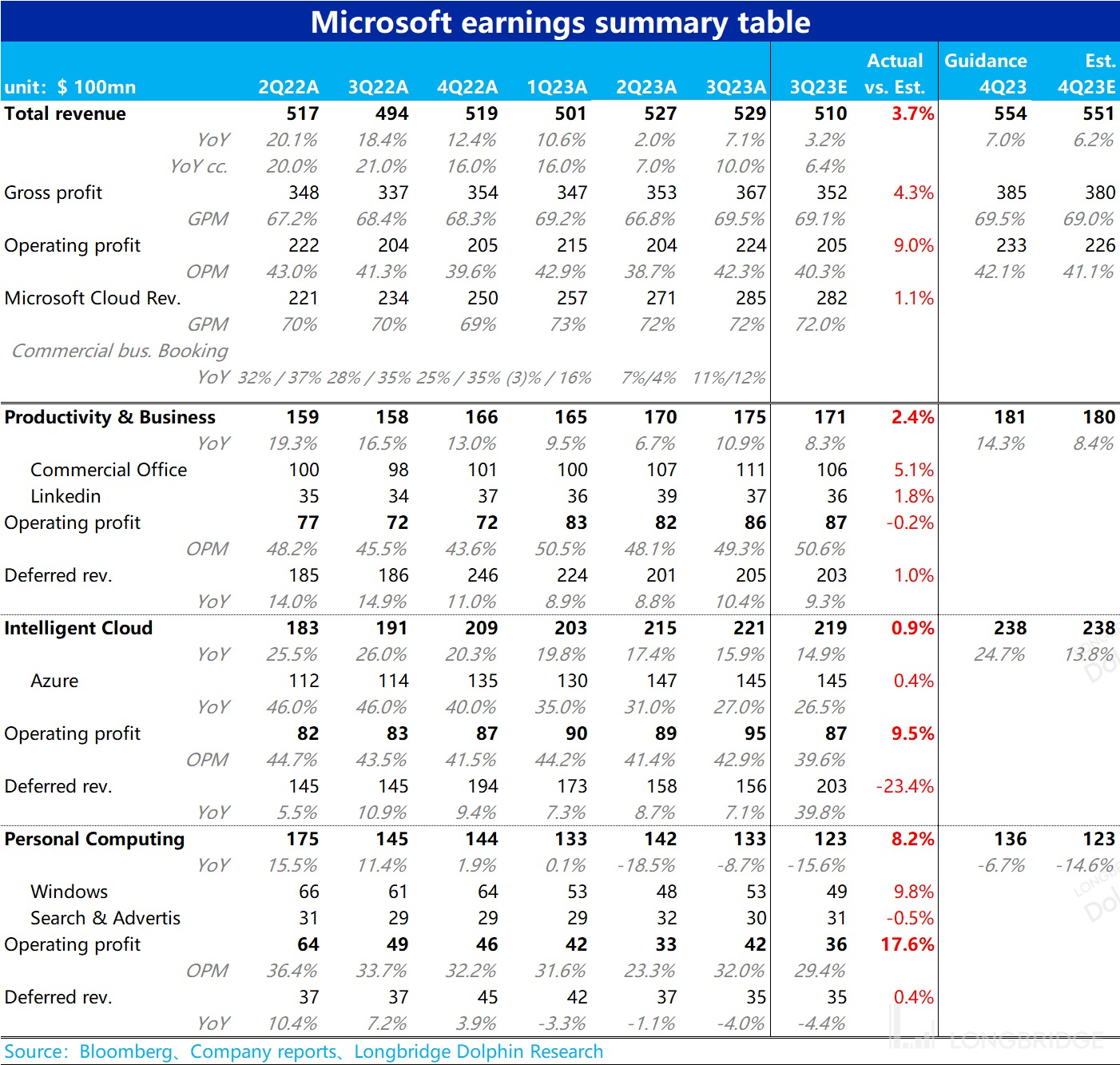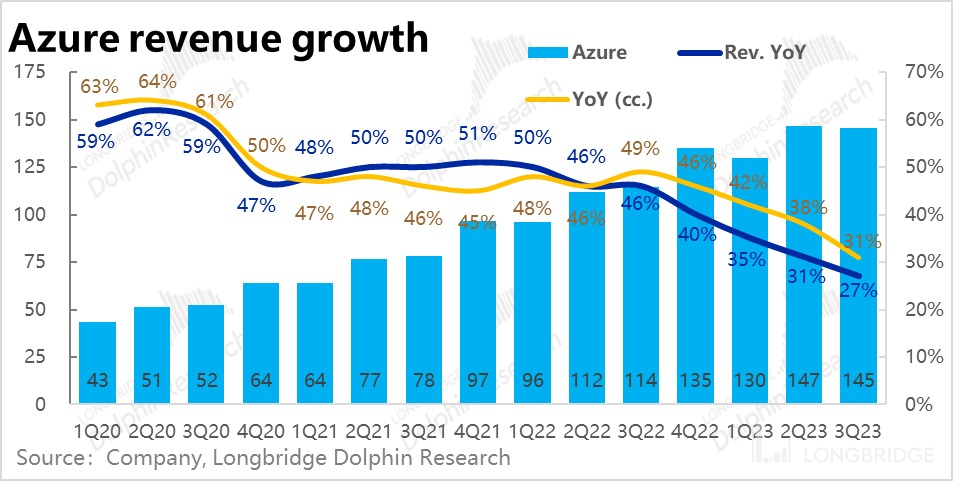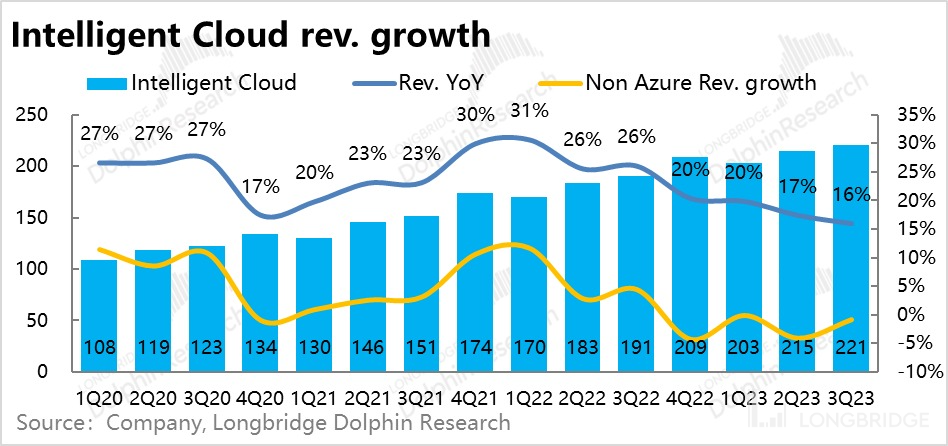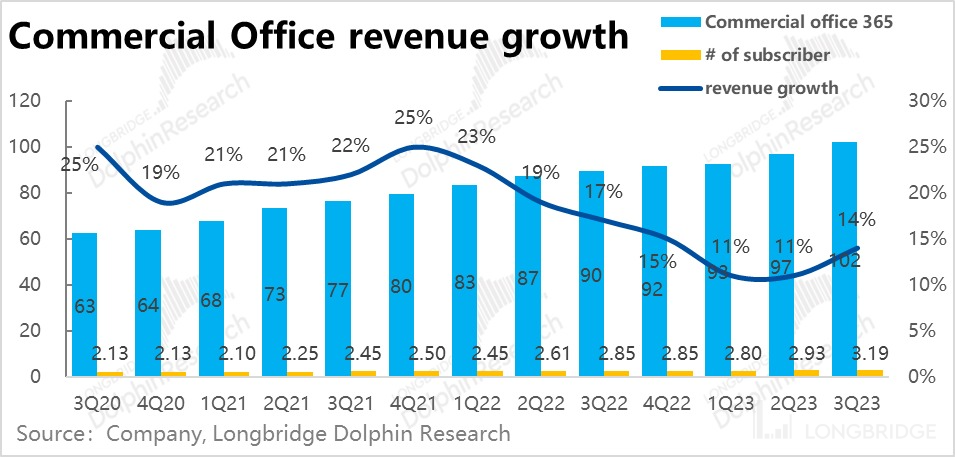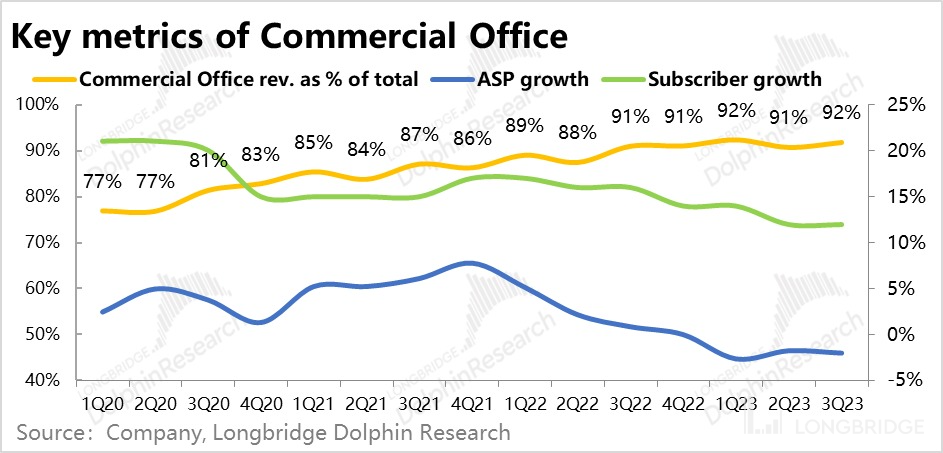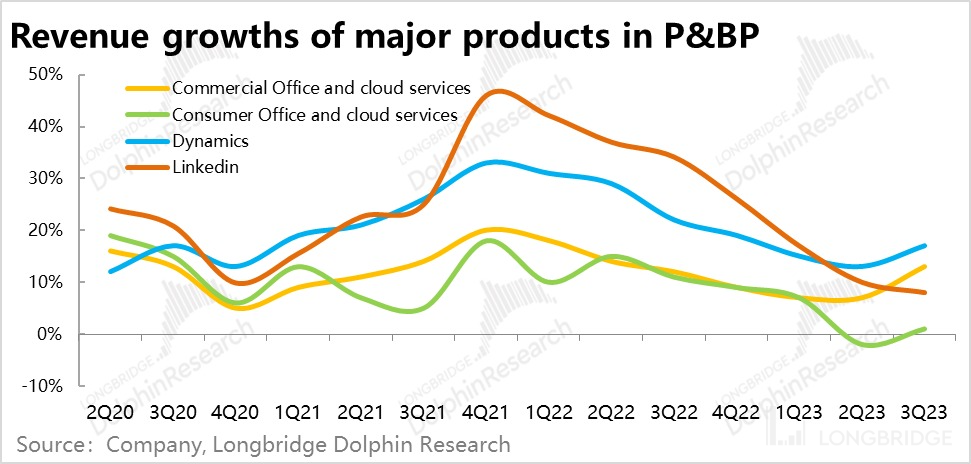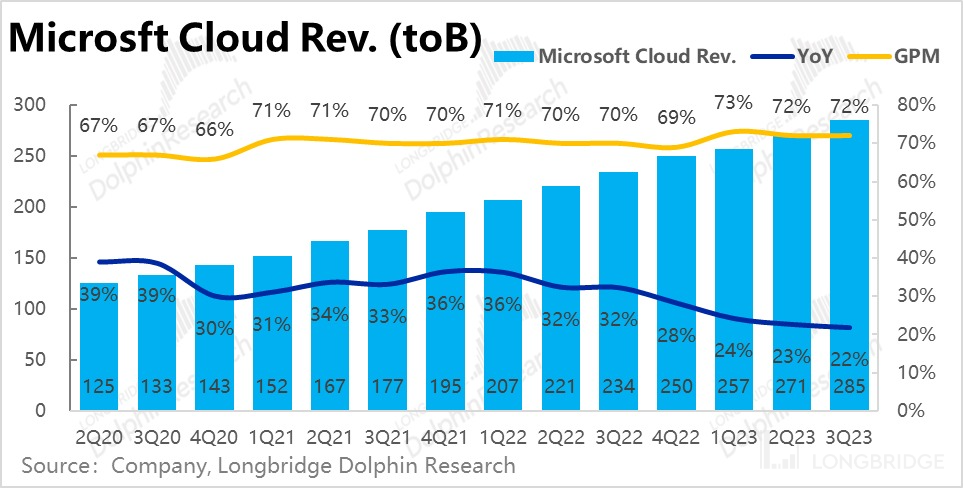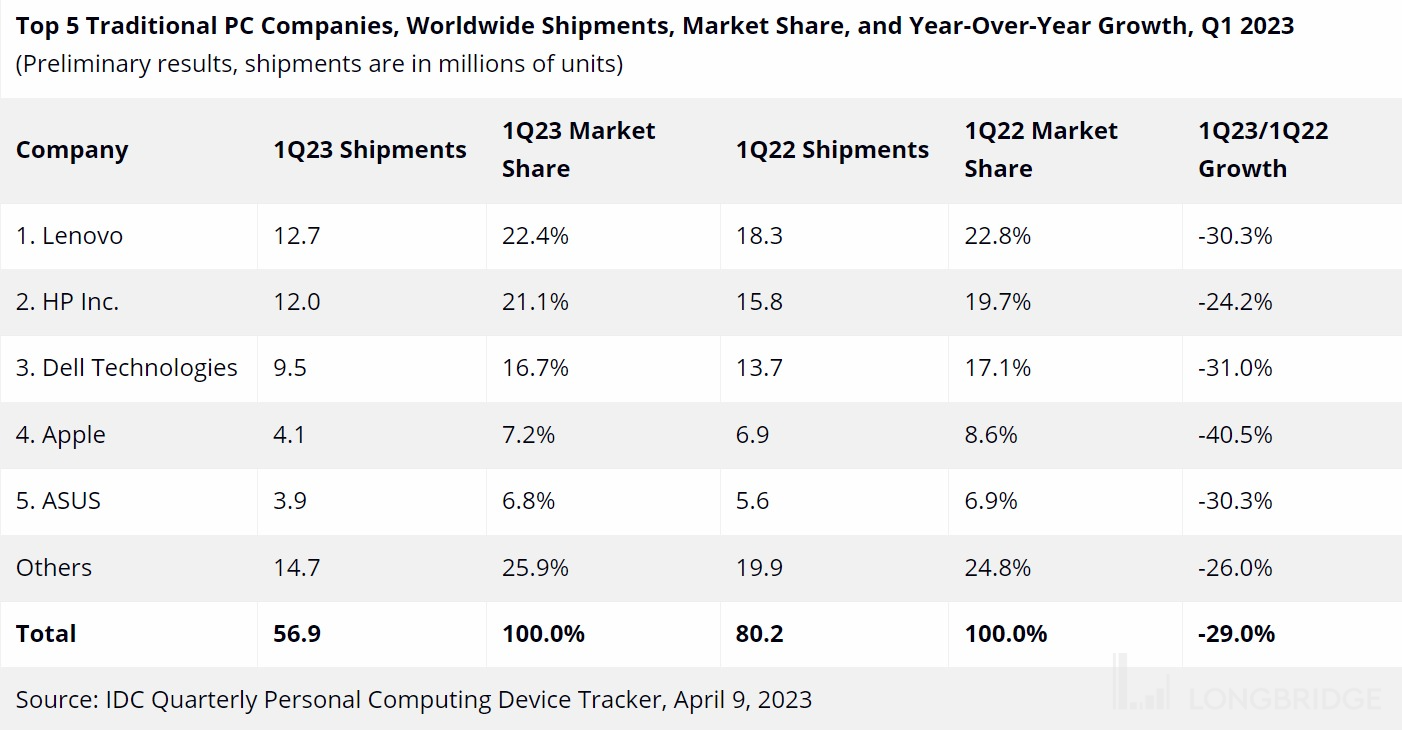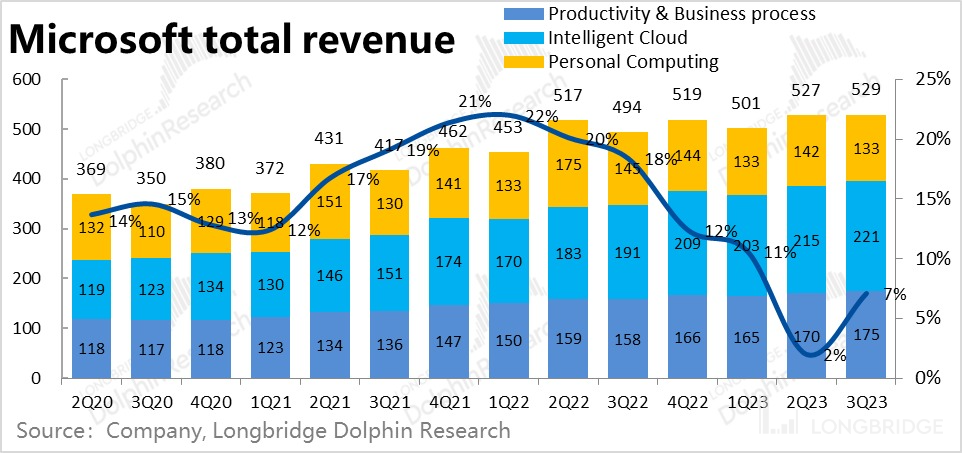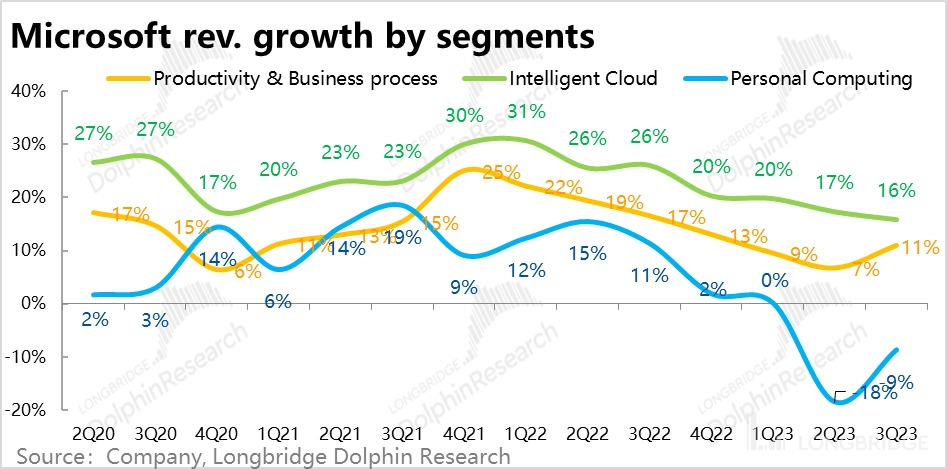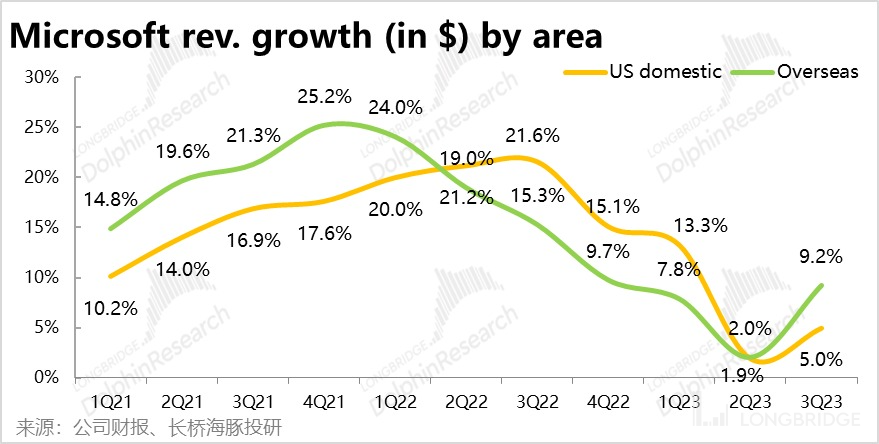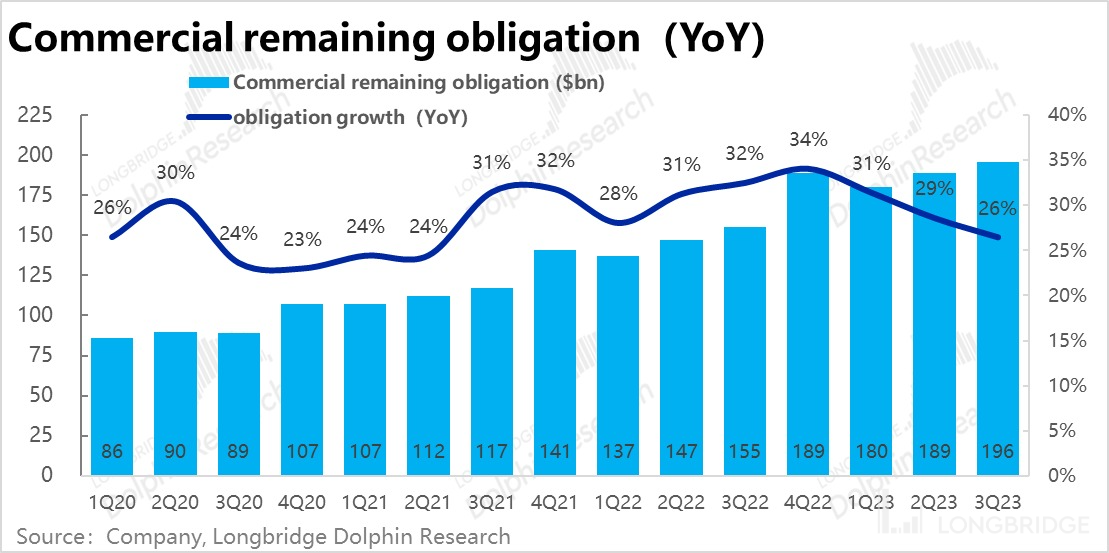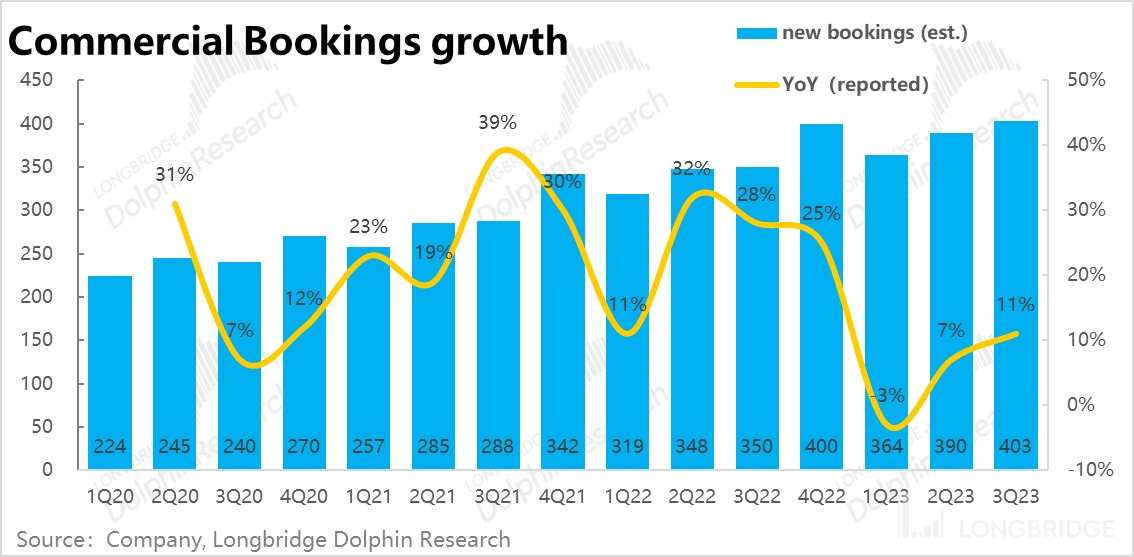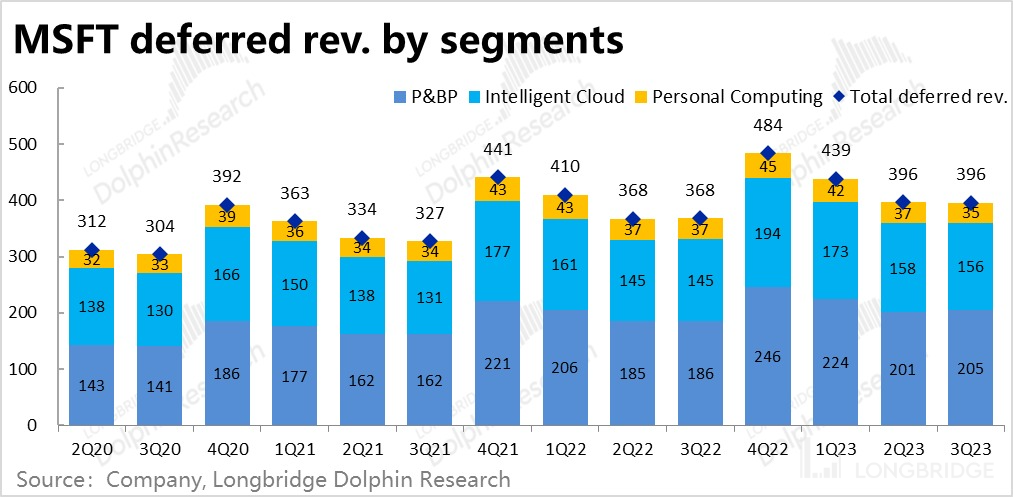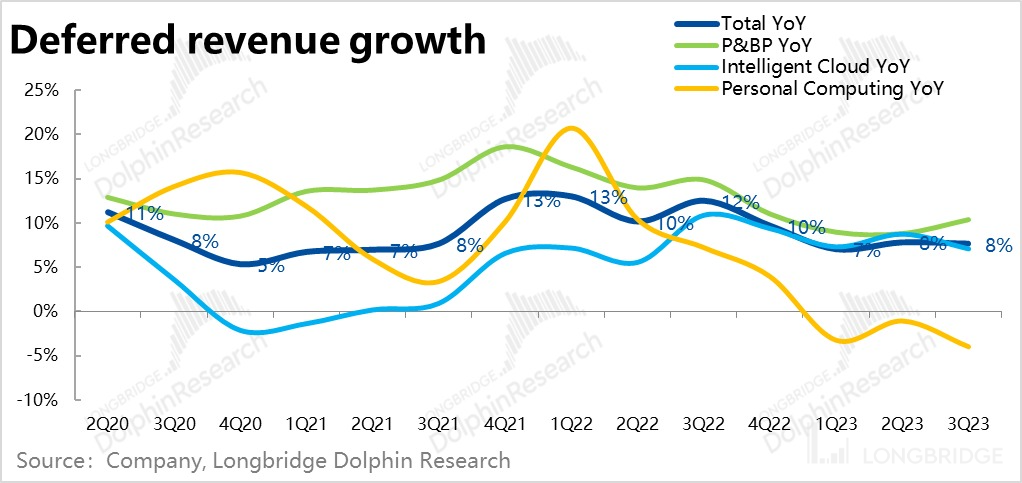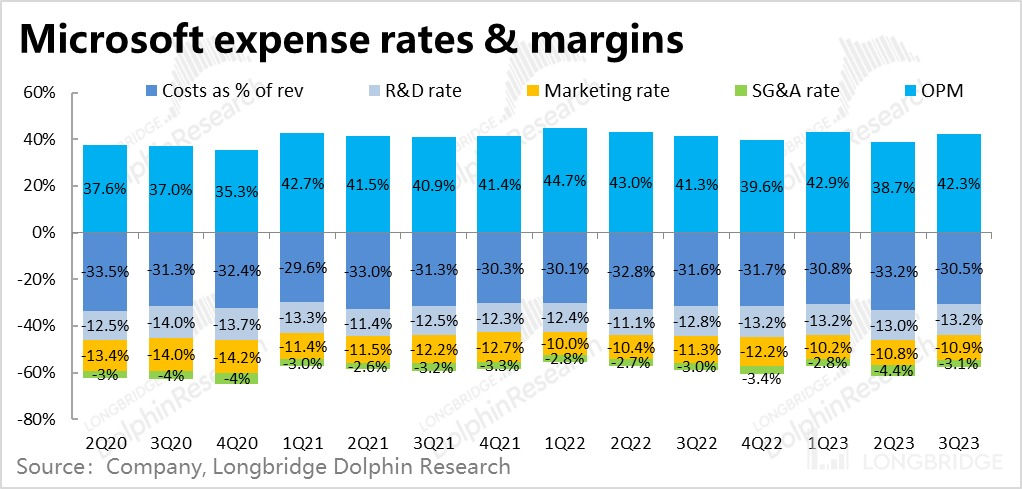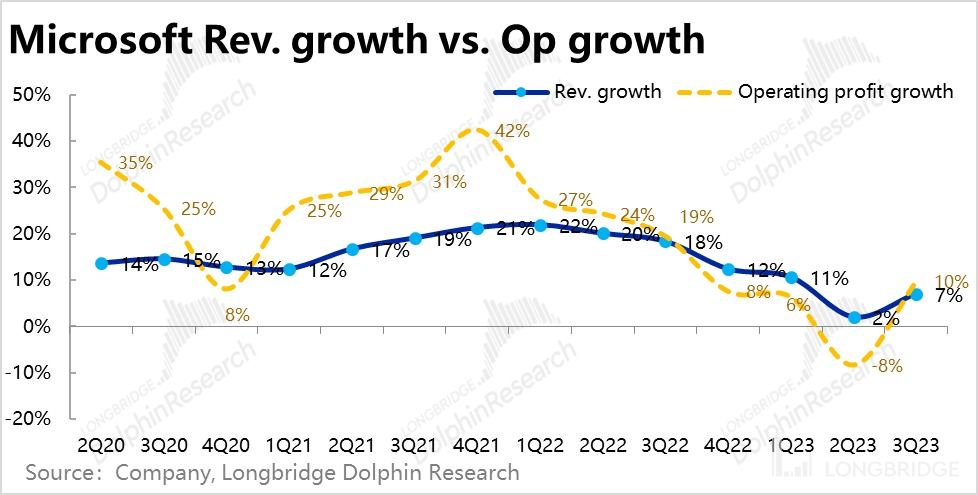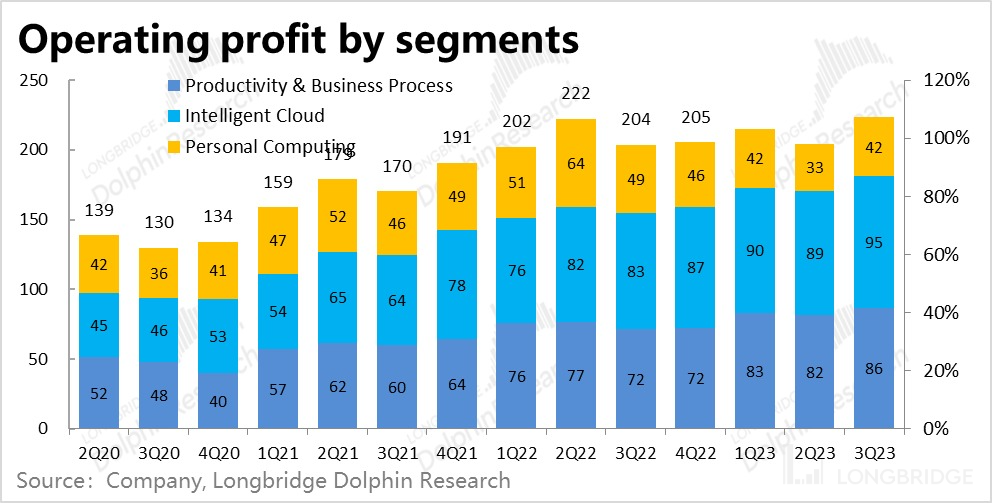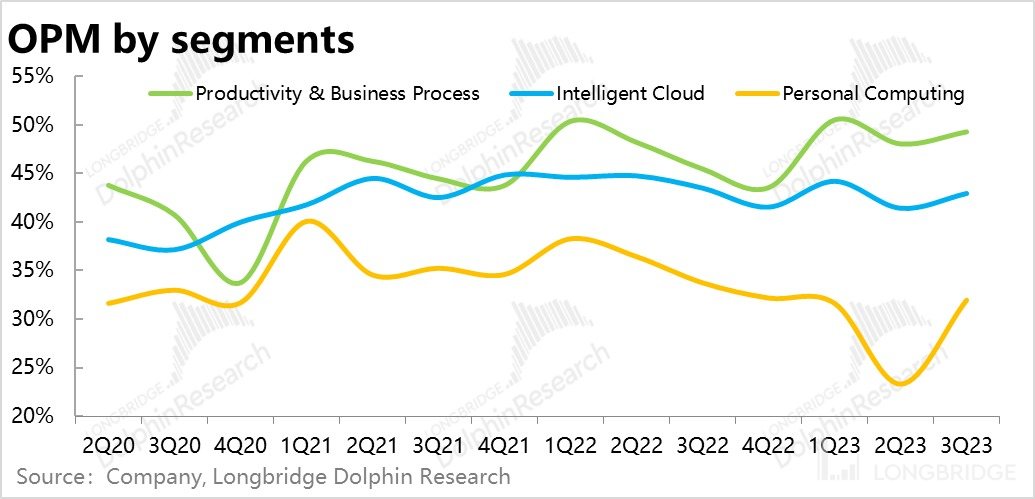
 Likes Received
Likes Received Posts
Posts"Microsoft" Microsoft out of the trough, can it take advantage of Chatgpt to soar again?

Microsoft $Microsoft(MSFT.US) announced its Q3 FY2023 financial results after the U.S. stock market closed on April 26. The key points are as follows:
-
Inflection point of performance has arrived (at least for now): Microsoft's total revenue for this quarter reached $52.9 billion, higher than the expected $51 billion, and the growth rate increased from 2% to 7% after hitting rock bottom. In addition, this quarter's operating profit of 22.4 billion yuan was also higher than the expected 20.5 billion yuan. At the same time, the profit growth rate rebounded from -8% in the previous quarter to +10%, breaking the strange circle of increasing revenue but not increasing profits.
-
The smart cloud business is still trending downward: Azure, Microsoft's flagship product, achieved revenue of $14.5 billion this quarter, and the year-on-year growth rate continued to fall from 31% to 27%. However, it was consistent with market expectations and had no surprises. However, after excluding exchange rate factors, the degree of slowdown in growth rate reached 7 percentage points, which shows that the demand for cloud services in enterprises is still quite weak.
-
Productivity and personal business lead the marginal rebound: In addition to the smart cloud, the revenue growth rates of the productivity process and personal computing segments rebounded by 4% and 9% respectively this quarter. Looking closely, the core enterprise Office 365 business of the productivity segment rebounded due to the base effect of stabilizing user growth and stopping the decline in customer unit price.
The personal computing business showed a performance of a nearly 20% YoY decline in revenue in the previous quarter, which made the market's expectations overly pessimistic. Although it still declined by 9% YoY this quarter, it appeared significantly improved under extremely low expectations.
-
Operating leverage is releasing again, and profit margins are returning: If the inflection point of Microsoft's revenue this time is more of a marginal recovery after there is no room for further decline, the recovery of profit is the real highlight. With the stabilizing revenue scale, operating leverage is released again, coupled with the company's cost-cutting and efficiency-improving measures, Microsoft's gross profit margin increased by 2.7 percentage points QoQ, returning to the level of F1Q, while the administrative expense ratio narrowed by more than 1.3 percentage points. As a result, Microsoft's operating profit margin this quarter reached 42.3%, significantly higher than the expected 40%. It also reversed the problem of the company's profit growth rate continuously lower than income for nearly three quarters. With cost reduction and efficiency improvement continuing, it is expected to return to a profit-release cycle where profits lead income growth rate.
-
Next quarter's revenue guidance is in-line, but profits significantly exceed expectations: Regarding the guidance for the next quarter, the overall performance is expected to repair the revenue as predicted, but the profit release is more pleasing. Specifically, the company's revenue guidance for the productivity process and smart cloud segments in Q4 is completely consistent with the market's previous expectations, but the guidance for the personal computing business, which the market had over-pessimistic expectations for, exceeded expectations by a significant margin.
However, the company's operating profit guidance for the next quarter is 23.3 billion yuan, significantly exceeding the market's expected 22.6 billion yuan, indicating that the trend of operating leverage release and profit recovery will continue to decline. Opinion of Changqiao Dolphin:
Overall, the most important observation from this season's earnings report is that there has been a "bottoming out and rebounding" trend. Whether it is the rebound in revenue growth or the return of profit growth, which has stopped declining and once again leads revenue growth, it all reflects that Microsoft has emerged from its previous performance slump and returned to the upward trend. As a result, as the company transitions from the logic of marginal continuous deterioration to the logic of excellent upward growth, market sentiment and stock performance will naturally recover.
However, specifically speaking, whether it is the performance this season or the guidance for the next quarter, Microsoft's core cloud and office revenue did not truly exceed expectations. At the same time, the powerful cloud computing Azure business is still in its infancy, and the real driver of the company's performance improvement is mainly due to the unexpected release of cost reduction and efficiency increase.
Therefore, combined with the company's currently not cheap valuation, Dolphin believes that investing in Microsoft at this point will not make money from the value return after the company is undervalued. Rather, it is necessary to expect the performance exceeding expectations or the creation of AI-generated performance and valuation imagination space, that is, money from neutral and reasonable to prosperous optimism.
Later, Changqiao Dolphin will share a summary of the conference call with its user group through the Changqiao App. Interested users are welcome to add the WeChat account "dolphinR123" to join the Changqiao Dolphin Investment Research Group and receive the conference call summary for the first time.
The following is a detailed review of the financial report:
I. Core Business is Not Retreating
1.1 Azure Continues to Decline as Expected
First, let's look at the fist product in Microsoft's intelligent cloud business, Azure, which achieved revenue of US$14.5 billion this quarter, with a year-over-year growth rate decreasing from 31% to 27%. However, it is basically in line with market expectations, which means it neither surprises nor disappoints.
After excluding the exchange rate losses caused by the appreciation of the US dollar, the real growth rate of Azure is 31%. However, what is worrying is that, under the constant exchange rate, the degree of growth rate decline has further expanded to 7pct, indicating that the impact of global corporate optimization of cloud computing usage on Azure demand is quite severe.

Since Azure, with the highest revenue proportion, has slowed down its growth, the overall revenue of the intelligent cloud business this quarter amounted to US$22.1 billion, with a slightly lower growth rate of 16%, but slightly exceeding the upper limit of the company's previous guidance of US$22 billion and the market's consensus mean expectation.
However, the non-Azure business in this section (including SQL server, Visual Studio, and enterprise consulting services, etc.) only dropped by -0.8% year-on-year, which is significantly better than the previous quarter's -4.1%. After a further weakening of cloud computing demand, traditional server business instead showed signs of stabilization.

1.2 The Office section no longer retreats, it moves forward
In this quarter, the revenue of SaaS product Office 365 aimed at enterprises reached 10.2 billion US dollars, a year-on-year increase of 14%, rebounding from the bottom after a continuous decline in growth for 6 quarters.
From the perspective of quantity and price: 1) The number of enterprise monthly subscription customers for Office365 in this quarter still increased by 12% year-on-year, which is the same as last quarter. After the Office cloud penetration rate approached the ceiling, the growth of new Office 365 users has entered a platform period.
-
From the price perspective, the unit price of this quarter's Office 365 remained unchanged at 18.3 US dollars (estimated by Dolphin), but due to the low base number last year, it stopped falling and rose by 2% year-on-year. Therefore, the real situation is that enterprise users' usage and unit price of Office 365 have stopped deteriorating and the revenue growth rate has begun to rebound with the help of a low base number.
-
Like the trend of subscription and unit price, the cloud penetration rate of the Office product also became flat this quarter. The proportion of Office365's revenue in the overall enterprise Office business income has slightly increased to 92% this quarter. After occupying 90% of the market share, the penetration rate is indeed difficult to improve logically and practically.

Consistent with the core enterprise Office business, most of the other businesses in the productivity and business process section have shown the trend of rebounding from the bottom in revenue growth.
Among them, the revenue of personal Office business stopped falling and rose to a positive growth rate of 1%; Dynamics and LinkedIn, these two relatively emerging businesses, also returned to 17% and 8% growth rates, respectively.
To be more specific, the revenue of cloud product Dynamics 365 and Commercial LinkedIn aimed at enterprise marketing both increased by about 25% this quarter. Compared with the growth of the non-cloud or personal business, the growth of cloud and enterprise business is more resilient.
 Overall, the overall revenue growth rate of the productivity and business processes (P&BP) sector has similarly bottomed out from 7% to 11%, achieving a total revenue of 17.5 billion yuan. From the perspective of expected differences, the core business of the sector, Enterprise Office Services, actually exceeded expectations by nearly 5%. The overall revenue of the sector was also higher than the market's expectation of 17.1 billion. Overall, Microsoft's P&BP sector seems to have hit bottom. With a further decline in the base, the sector's growth is expected to return to the central level after the difference can't get any worse.
Overall, the overall revenue growth rate of the productivity and business processes (P&BP) sector has similarly bottomed out from 7% to 11%, achieving a total revenue of 17.5 billion yuan. From the perspective of expected differences, the core business of the sector, Enterprise Office Services, actually exceeded expectations by nearly 5%. The overall revenue of the sector was also higher than the market's expectation of 17.1 billion. Overall, Microsoft's P&BP sector seems to have hit bottom. With a further decline in the base, the sector's growth is expected to return to the central level after the difference can't get any worse.
To better evaluate the performance of enterprise cloud services, Microsoft independently disclosed that enterprise cloud service revenue (Microsoft Cloud Revenue) reached 28.5 billion this quarter by aggregating cloud income from the Intelligent Cloud segment and cloud income from the Productivity segment, including Enterprise Edition Office 365, Dynamics 365, LinkedIn for Enterprise, and Azure. The growth rate slowed by 1% to 22%, which was expected as the trend of slowing growth continues. The gross margin of enterprise cloud services remained at 72% this quarter, stabilizing as server operating costs stabilized after the company reduced expenses to cope with inflation and energy prices dropped globally.
In comparison with the cloud business and productivity business oriented towards the B-side, Microsoft's personal computing business oriented towards the C-side is relatively less valued by the market. It is a "legacy" business of Microsoft in the era of PC Internet. After the boom of the "stay-at-home economy" during the pandemic, the PC business is in a downturn.
Against this background, Microsoft's personal computing segment achieved revenue of $13.3 billion this quarter, narrowing the year-on-year decline from -18% in the previous quarter to -9%. It is also significantly higher than the company's upper limit guidance of $12.3 billion and market expectations. Although the sector's revenue is still shrinking, it has also passed the worst stage.
Specifically, 1) Windows business revenue fell by 12% year-on-year, and OEM revenue related to PC shipments fell by 28%, consistent with the 29% decline in global PC shipments as reported by IDC this quarter. 2) The decline in hardware sales revenue, primarily from the Surface product line, has narrowed from -37% to -27%; 3) The year-on-year decline in Xbox software and content revenue in the gaming business has also narrowed to only -4%; 4) Advertising business growth, which is more closely related to macroeconomic trends, continued to slow to 3% (according to Dolphin calculations), but the growth rate excluding acquisition costs remained at 10% compared to the previous month.

"In general, both the overall sector and the revenue of each specific business are basically the same as in the first quarter of this year. Similar to the P&BP sector, it is also the turning point of stagnating performance deterioration, gradually reaching the turning point of a rebound as the base decreases. The expected demand for personal computing business, which is reflected by the company and the market, has not continued to deteriorate."
"3. Growth Rebounds, and US Domestic and Multinational Corporations are the Decisive Factors."
"At the bottom, there will always be a turning point. This quarter, Microsoft's overall revenue was $52.9 billion, surpassing the seasonal high point of the second quarter (reality fourth quarter), and significantly higher than the market's anticipated $51 billion. Although the smart cloud business had the best growth in absolute value, and although the growth trend is still slowing, the productivity tool business and personal computing business, which have weaker performances, rebounded from the bottom. The company's overall revenue growth also rebounded from the previous quarter's 2% to 7%."


"3.2 Exchange Rates Have a Lesser Impact, and Multinational Corporations Are the Problem?"
"Due to the appreciation of the US dollar, exchange losses in the past few quarters have had a significant negative impact on Microsoft's performance. However, as the US economy weakens, the strong US dollar has also begun to decline, and the negative impact of exchange rates on revenue has decreased from 5.0% in the previous quarter to only 2.9%. With the future peak and subsequent decline of US interest rates, the negative impact of exchange rates on performance will gradually disappear."

"At the same time, another point worth noting is that this quarter's overseas revenue (measured in US dollars) has rebounded significantly to 9.2%, while the growth in the US is still relatively low at 5%. Given the dragging effect of the US dollar exchange rate on overseas revenue, Microsoft's overseas revenue growth has been higher than that of the US for two consecutive quarters. One possible reason behind this is that all multinational group customers' income is classified under US domestic income. Dolphin speculates that one reason for the continuous weakness of US income is that multinational groups have been more aggressive in reducing IT expenses this time than small and medium-sized enterprises." **

Four. Can the "leftover grain" perform well?
As seen from the previous section, Microsoft's businesses, other than intelligent cloud, have bottomed out and rebounded, and have passed through the worst phase (so far). Will the future performance continue to improve? We can get a glimpse from the "leftover grain" of unconfirmed revenue disclosed by the company.
First, let's look at the remaining balance of to B business contracts, which is "leftover grain" in the long term: The balance of unconfirmed revenue in this quarter (i.e., the deferred revenue from payments received but not confirmed + the amount of the contract signed but not yet paid) is 196 billion yuan. It continues to marginally slow down in line with the previous trend, but the rate of decline has not deteriorated. It belongs to the trend of gradual slowdown with the base size gradually increasing and no additional growth momentum.

The more critical increase in this quarter is the estimated new enterprise contract amount signed in the quarter, which is approximately 40.3 billion US dollars, reaching another historical high. The growth rate of newly signed contract amount also rebounded from 7% in the previous quarter to 11%. After removing the exchange rate factor, the growth rate further increased to 12% . Judging from the rebound in the growth of the new enterprise contract balance, the performance of Microsoft's core to B business is probably not too bad.

The company has received payment, so the short-term "leftover grain" with higher certainty - the deferred revenue this quarter is 39.6 billion US dollars (most of which will be confirmed as revenue within one year), which remains basically unchanged from the previous period and is consistent with historical experience. Structurally, the deferred revenue of the personal compute business is still declining year-on-year, so the certainty of short-term performance in the future is still low. As for the deferred revenue of the productivity process and intelligent cloud business, it is consistent with the trend of confirmed revenue this quarter, the former has bottomed out and rebounded, and the latter is still at the bottom.


Five. Releasing operating leverage to break the cycle of growth without profit
With Microsoft's revenue growth rate showing signs of bottoming out, combined with the cost reduction measures such as layoffs taken by the company, Microsoft's profit level has also begun to recover as expected this quarter. Specifically:
**======

1)This quarter achieved a gross profit of $36.7 billion, with a gross profit margin rebounding to 69.5%, the same level as the first quarter of fiscal year in terms of revenue regression. Regarding why gross profit significantly deteriorated in the previous quarter and quickly repaired this quarter, we can pay attention to whether there will be any explanation in the subsequent management conference call.
2)In addition to significant improvement in gross profit, the narrowing of administrative expenses is the second driving force that helps to increase profits. The management expense ratio this quarter has significantly narrowed from 4.4% in the previous quarter to 3.1%, demonstrating the company's good control of internal expenses. Research and development and marketing expenses closely related to business development remain stable.
Overall, mainly due to the repair of gross profit margin, the company achieved an operating profit of $22.4 billion this quarter, significantly higher than the market's expected $20.5 billion, and the operating profit rate increased from 38.7% in the previous quarter to 42.3%. This quarter also finally reversed the problem of revenue growth without profit growth, with operating profit growth rate reaching 10%, leading the revenue growth of 7%.


3)Looking at the business segments, all segments have basically rebounded to the profit level of the first quarter of the financial report from the trough of the previous quarter. Among them, the severely affected personal computing segment showed the most obvious improvement, with actual operating profit higher than market expectations by 18%. In addition, the operating profit of the smart cloud business was nearly $800 million higher than expected.


Previous research:
Financial Report Review
January 25, 2023 Conference Call "Inevitable Slowing Down (Microsoft Conference Call Summary)"
January 25, 2023 Financial Report Review "Resilient Azure Cannot Save Microsoft in the Cycle" On October 26, 2022, the conference call "Can Microsoft Safely Navigate the Economic Downturn? (1Q23 Conference Call Minutes)" was held.
On October 26, 2022, the financial report "No one is immune to the business cycle, and Microsoft is struggling too" was released.
On July 27, 2022, the conference call "How Microsoft Views Its Fiscal Year 23 Performance (Conference Call Minutes)" was held.
On July 27, 2022, the financial report "Under Software Paralysis, Microsoft Has Stronger Confidence" was released.
On April 27, 2022, the conference call "Microsoft's Journey is the Real Starry Sea (3Q Conference Call Minutes)" was held.
On April 27, 2022, the financial report "Microsoft, the Strongest Pillar in the US Stock Market" was released.
On January 26, 2022, the conference call "Nadella: 'Microsoft's Strength Lies in Being Able to Anticipate Trends Before a Consensus is Reached'" was held.
On January 26, 2022, the financial report "Microsoft Can be Trusted Without Worry" was released.
In-Depth Research
On May 30, 2022, "Microsoft Is Faultless, Killing the Price Would Make It Perfect" was released.
On February 15, 2022, "Microsoft: Don't Focus on Poor Expectations, Having Orders and Reserves is the Key" was released.
On November 22, 2021, "Why Can Microsoft Get Stronger While Alibaba and Tencent Are Prematurely Aging?" was released.
Risk Disclosure and Statement for this article: Dolphin Investment Research Disclaimer and General Disclosure.
The copyright of this article belongs to the original author/organization.
The views expressed herein are solely those of the author and do not reflect the stance of the platform. The content is intended for investment reference purposes only and shall not be considered as investment advice. Please contact us if you have any questions or suggestions regarding the content services provided by the platform.

